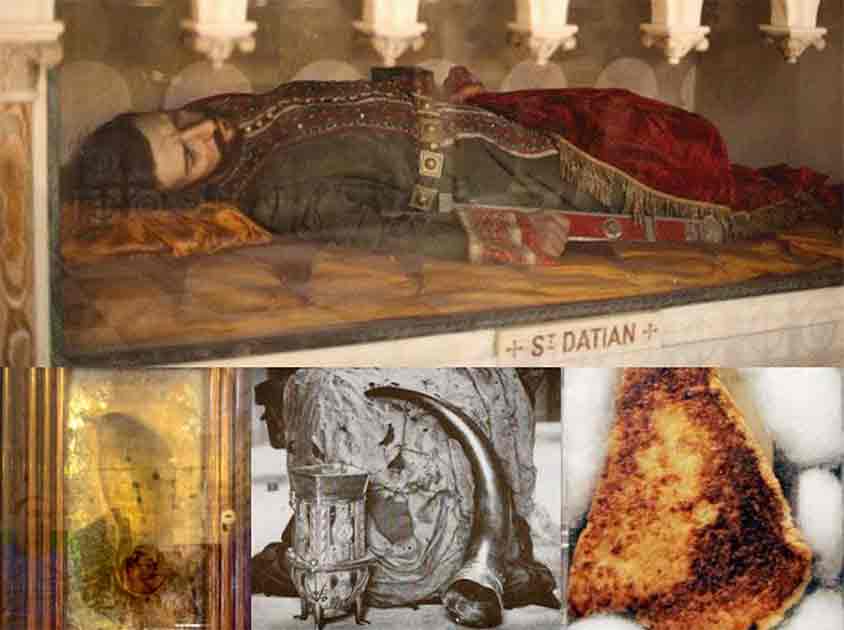Footprints, Fairies and even a Foreskin: 9 Bizarre Relics from History
From time immemorial, people had the need to venerate objects of great significance: religious relics, mythical symbols or depictions of holy figures. As if in answer to this need, the religious establishment has provided. Throughout time relics have been widely worshiped throughout the world. Some of them are relics in the true meaning of that term: holy items of ancient times that are a marvel to witness. Then again, some of these bizarre relics are simply strange. Reading about them we can easily explore the limits of human belief and analyze the complex anatomies of faith.
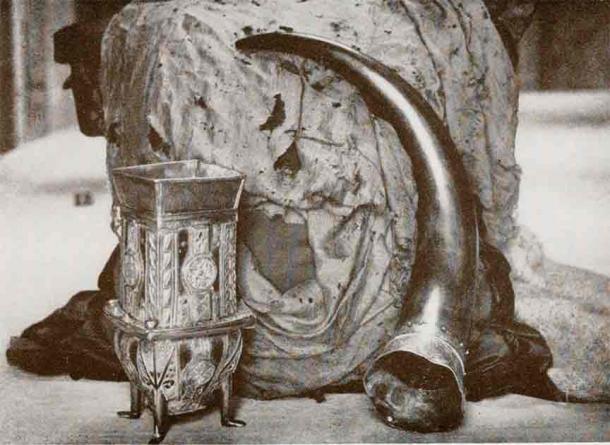
The Fairy Flag is a bizarre relic, said to have been gifted to the MacLeod chiefs by fairy folk. (Public domain)
Bizarre Relics #1. The Fairy Flag: Strange Relic of the MacLeod Clan in Scotland
A relic is not necessarily a religious item. Some of them can be important heirlooms and artifacts with a lengthy heritage and history. One such item is the so-called Fairy Flag, a venerated heirloom of the Chiefs of the Scottish Clan MacLeod. Known in Scottish as Am Bratach Sìth, it is kept in the clan’s seat at Dunvegan Castle and is considered an indivisible part of their heritage.
- Relic Cults: Why Dead Saints Were So Important in the Middle Ages
- Medieval Relic List Includes Santa’s Bone and Christ’s Crib
The Fairy Flag is made from silk that originated in the far east, denoting its luxury status on the remote Isle of Skye. Being very old, it is now quite torn and tattered, as well as being covered with tiny red “elf spots.” This bizarre relic has attained legendary status and is said to have magical properties and healing powers. Its origins are somewhat enigmatic, as the legends state that the MacLeod chiefs were presented with the flag by fairy folk. However, scholars suggested that its origins might lie not with the fairies, but in the Crusades, or the Viking invasions, for whom it could have been a raven banner. Nevertheless, it remains as one of the most precious and strangest in Scotland.
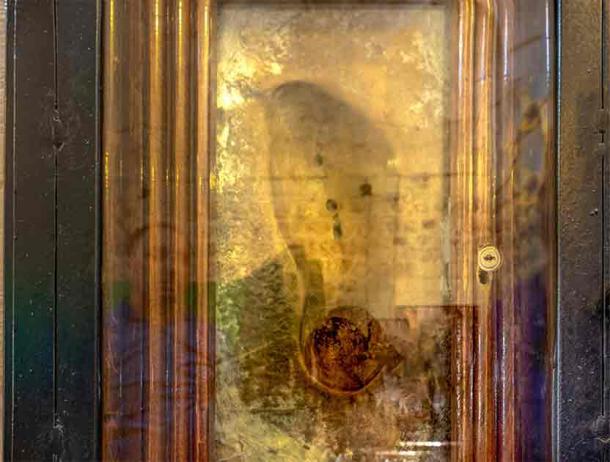
Footprints of the Prophet Mohammad exist across the Islamic world. (epic_images / Adobe Stock)
Bizarre Relics #2. The Footprints of Muhammad: Petrified Relics of the Prophet
The founder of Islam, the Prophet Muhammad is the most venerated figure of this widespread religion. Accordingly, just like in Christianity, religious relics associated with him are aplenty. But one stands out as quite peculiar: the petrified footprint of Muhammad. Some Muslims believe that wherever the prophet stepped, his left foot made an impression that remained fixed in place.
According to numerous written and oral sources, this prophet left numerous such footprints across the Arabic world. One such alleged footprint is located in the Topkapi Palace in Istanbul, where it is venerated by thousands of believers every year. Some other notable examples of his preserved footprints are located in the mausoleum of Qaitbey in Cairo, or in the Mosque of the Footprint in Qadam, just south of Damascus and directly on the pilgrimage route to Mecca.
Numerous legends are associated with these peculiar relics. One legend says that a royal eunuch of the Nizam (Muslim Indian sovereign) once discovered an imprint after being guided to it by a dream vision of the prophet himself. Whatever one might believe, a petrified footprint is certainly a strange phenomenon, as well as being difficult to skillfully replicate or fake.
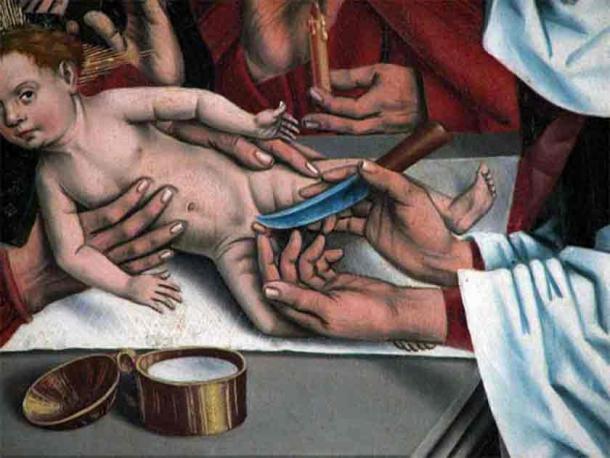
The holy prepuce of Jesus Christ is one of the most bizarre relics in existence. Detail from The Circumcision of Jesus by Friedrich Herlin, an event described in the Gospel of Luke. (Public domain)
Bizarre Relics #3. The Holy Prepuce of Jesus Christ
Possibly one of the strangest relics in the world, the Holy Prepuce—also known as the Holy Foreskin—is just another in a long line of bizarre relics associated with Jesus Christ. This relic allegedly originates from the circumcision of Christ and became an important religious item in the early periods of Christianity. Numerous healing powers have been attributed to this foreskin, which was soon claimed as a prized item by several churches in Europe.
Alongside the umbilical cord of Christ, the foreskin had a long and turbulent journey in medieval Europe. In 800 AD it was given as a present to Pope Leo III by King Charlemagne, who most likely received the bizarre relic as a present from the Byzantine Empress Irene. The Pope housed the relic in a lavish jeweled gold cross, which was kept under the altar of the Chapel of Saint Lawrence in Rome.
Alas, with the Sack of Rome in 1527, the jeweled cross with Jesus’ foreskin was looted. It was later retrieved in a village north of Rome, Calcata, where it was reportedly kept until 1983, when it was yet again stolen. However, its authenticity at that time was dubious at best and the question of whether the Holy Foreskin ever actually existed remains unresolved. Nevertheless, as far as peculiar relics go, the veneration of a foreskin is definitely an unusual practice.
![Modern, digitally processed image of the face on the shroud of Turin [left]. (Public domain) The full body image as seen on the shroud [right]. (Public domain)](https://www.ancient-origins.net/sites/default/files/styles/large/public/modern_10.jpg?itok=e17AmFER)
Modern, digitally processed image of the face on the shroud of Turin [left]. (Public domain) The full body image as seen on the shroud [right]. (Public domain)
Bizarre Relics #4. The Turin Shroud
The Shroud of Turin, known as La Sindone in Italian, has captivated the imagination of scholars and believers alike for centuries. Believed to have once been used to wrap the body of Christ after his death, it is a mysterious relic shrouded in controversy. Measuring approximately 14-feet (4.27 m) in length, this unassuming pale sheet of woven fabric bears distinctive reddish-brown markings on both its front and back, depicting the image of a prone man with hands folded. The hauntingly vivid portrayal showcases countless wounds, from slashes to gouges, evoking the brutal agony of crucifixion, which proponents argue aligns with the biblical account of Jesus Christ's death.
- Divine Relics: The Miracle Rings of Ourense (Video)
- Furta Sacra: Medieval Trafficking In Saintly Relics
Historical records trace the shroud's presence to the late 1300s, though its origins remain unknown. Disagreements over its authenticity surfaced even during the Middle Ages, with conflicting claims suggesting it to be either a sacred relic or an elaborate forgery. However, it wasn't until the 15th century that the shroud gained widespread attention, particularly following its acquisition by the House of Savoy in Italy and subsequent public display. Yet, it was the advent of photography in the 19th century that propelled the shroud to international fame, as detailed images of a wounded, bearded man emerged upon viewing the photographs' reverse negatives. Today it is one of the most studied religious artifacts in the world.
Despite numerous scientific examinations, the shroud continues to defy easy explanation. While some findings suggest the image to be that of a real human form, questions persist regarding its precise origins and the mechanism by which the image was imprinted onto the fabric. Radiocarbon dating conducted in 1988 yielded unexpected results, placing the shroud's material within a timeframe conflicting with Jesus Christ's era. Yet, subsequent investigations, including DNA analysis, have only deepened the mystery, revealing traces of genetic material from various regions across the globe. As debates rage on regarding its authenticity, the Shroud of Turin remains a perplexing enigma, challenging both scientific inquiry and religious faith alike. It is currently housed at the Duomo of Torino in Turin, Italy, but the shroud itself is not on display.

Golden Palace Events purchased the bizarre religious relic, a grilled cheese sandwich with a depiction of the face of the Virgin Mary, back in 2004 for a stunning $28,000! (Golden Palace Events)
Bizarre Relics #5. The Virgin Mary Grilled Cheese Sandwich
Yup, you read that right. When it comes to religious relics, the options are limitless, and not all religious relics were discovered in ancient history. The old toast and sandwich manifestation of holy figures is the true relic of modern times, as strange as it may seem. A woman from Fort Lauderdale in Florida, USA, named Diana Duyser, sold her 10-year-old grilled cheese sandwich in 2004—with one bite taken out of it—for $28,000 on an online auction! But it was no ordinary grilled cheese sandwich: it allegedly bore the image of the face of the Virgin Mary. Mrs. Duyser kept the sandwich sealed for 10 years before deciding to try and sell it— never once assuming its potential value.
For the faithful, it could be called a miracle. However, those with a bit more reason will realize that it is simply a curious coincidence: the dark crust formed a pattern that surprisingly accurately depicts a female face. This modern-day bizarre relic was bought by an online casino, the Golden Palace, whose representatives say that they quickly understood the novelty of such a “recognizable part of modern pop culture.” They did not hesitate to pay $28,000 (£20,113) to own it. This makes it the world’s most expensive grilled cheese sandwich!
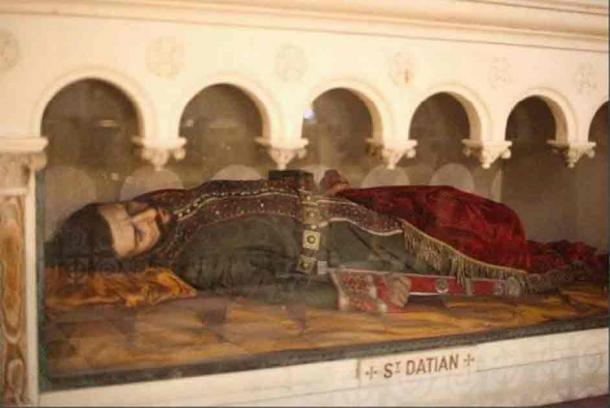
Wax effigy of St. Datian at the Church of the Most Holy Redeemer in New York. (Village Preservation Blog)
Bizarre Relics #6. The Remains of St. Datian in New York
The tradition of Catacomb Saints spread like wildfire through the Christian world, when holy relics and the preserved skeletons of “saints” began emerging throughout the world. One holy relic stands out as notably stranger than the rest, making its way all the to New York. This bizarre relic is the body of Saint Datian.
This odd relic is housed in a glass sarcophagus in the Church of the Most Holy Redeemer in East Village, New York City. Not much is known about Saint Datian. In fact, this saint is virtually unknown in preserved written sources. It is possible that Datian was a cruel Roman leader who persecuted Christians zealously, but later repented, became a monk and was later martyred.
The remains (bones) of this saint arrived at the church in 1892 and were kept in a lifelike wax effigy. A donation from a wealthy Italian lady, the origins of the bones themselves remain cloaked in mystery. However, doubts regarding their authenticity arose swiftly. As early as 1897, speculation emerged suggesting that the encased remains might instead belong to a police officer who was shot and killed while safeguarding the church from a burglary. This skepticism persisted widely until the late 1940s. Despite the passing decades, the truth behind this curious relic remains elusive.
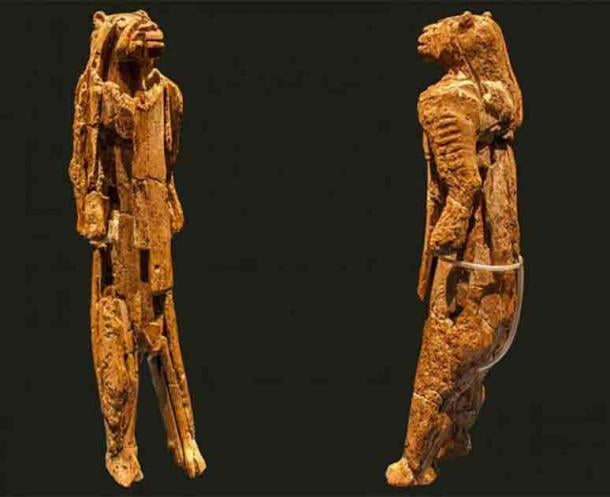
The Lion-Man of the Hohlenstein-Stadel was discovered in a cave in 1939 in Germany and is considered the oldest zoomorphic figurine in the world. (Left: Dagmar Hollmann / CC BY-SA 3.0. Right: Thilo Parg / CC BY-SA 3.0)
Bizarre Relics #7. The Lion-Man of the Hohlenstein-Stadel: Prehistoric Ivory Relic
Religion—whether monotheistic or polytheistic—has deep and ancient origins. What beliefs did our earliest ancestors have? Have some of their ancient relics survived until today? The Lion-Man, known also as Löwenmensch, is an elaborate prehistoric mammoth ivory figurine that quite possibly depicts an ancient mythical being worshipped by the prehistoric man. In 1939 it was discovered in a cave in Germany and is considered the oldest zoomorphic figurine in the world. Dated to the Upper Paleolithic, it is roughly 40,000 years old and was made from mammoth ivory.
- Even Today, Virgin Mary Milk Powder is Used as a Cure for Infertility
- St Helena, Discoverer of the True Cross, Was the First Archaeologist
Researchers concluded that the lion-headed figure was an important part of the mythology of the Paleolithic humans inhabiting this region. Some have even claimed that this bizarre relic might be one of the earliest pieces of evidence of shamanism. It deepens the mystery of numerous Paleolithic depictions of “beast-men,” like the bird-headed man from the Lascaux Cave, the lion-woman from Chauvet Cave, or the stag-headed “Sorcerer” from the Trois Frères cave. Prehistory was undoubtedly strange, seen now from our modern point of view, and ancient relics are all that remains of their belief systems.
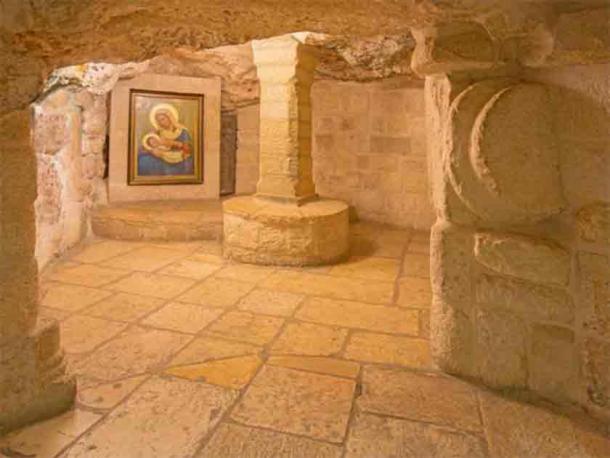
The Chapel of the Milk Grotto of Our Lady in Bethlehem takes its name from the belief that the Virgin Mary found refuge in a cave with the infant Jesus and a drop of her milk fell on the cave floor, turning it white. (Renáta Sedmáková / Adobe Stock)
Bizarre Relics #8. Breast Milk of the Virgin Mary in Bethlehem
Another in a long line of strange Christian relics is the so-called breast milk of the Virgin Mary. “The Nursing Madonna,” or Maddona Lactans, has been often depicted in Christian religious art, nurturing the baby Jesus at her breast. But did you know that her breast milk is venerated as a relic?
Situated in the Chapel of the Milk Grotto of Our Lady in Bethlehem, some 10km south of Jerusalem, ever since the Byzantine Era this site has been frequented as a major Christian pilgrimage site. It is believed that Virgin Mary found refuge in this grotto with the infant Jesus. Legend has it that as she breastfed him, a drop of her milk fell on the cave floor and miraculously turned it white.
Pilgrims, especially couples seeking to conceive, visit this revered site, believing in its miraculous powers to aid those struggling with infertility. The Catholic officials sought to capitalize on this belief, selling limestone powder made from the stone of the grotto, which ought to be diluted in water and drank. It supposedly helps cure infertility. You thought that veneration of a foreskin is strange? How about drinking powdered cave floor? This bizarre relic is as strange as it gets.

The Venus of Hohle Fels (Ramessos / CC BY-SA 3.0)
Bizarre Relics #9. The Venus of Hohle Fels: 40,000-Year-Old Ivory Sculpture
Venus figurines are the most iconic relics of the world’s earliest history. These fertility symbols were one of the major cultic items for early humans, offering insight into their cryptic and mysterious beliefs. The Venus of Hohle Fels is one of the strangest of all ancient relics, and can be interpreted in many ways. Unearthed in the Hohle Fels cave in Germany, this ivory sculpture is dated to the very beginning of the Upper Paleolithic period, some 40,000 years ago. It is the oldest undisputed depiction of a human being and gives us a crucial glimpse into the earliest origins of Cro-Magnons in Europe.
This relic might look strange to us, but for early man it might have been a revered mythical concept. It depicts a buxom—perhaps even obese—woman with enormous breasts, a large (pregnant) belly and a prominent vulva. These are clear connections with fertility. It can be easily understood that life was quite hard in the Upper Paleolithic and infant death rates could have been quite high. People were also probably malnourished and lean, so a depiction of a buxom woman could have been an ideal of health, fertility, prosperity and good life. Either way, we will never know the true meaning of the Venus figurines, and this one remains a truly bizarre ancient relic.
Top image: The relics humans have chosen to worship over the course of human history can often help us understand the extent of belief systems and the anatomies of faith. Source: Top: Village Preservation Blog Bottom: epic_images / Adobe Stock; Public domain; Golden Palace Events
References
Bryll, W. M. 4 August 2020. “Top 10 Weird Christian Relics” in Daily Art Magazine. Available at: https://www.dailyartmagazine.com/top-10-christian-weird-relics/
Harper, E. 22 May 2013. “Documenting the Holy Dead Through Saints’ Relics” in Atlas Obscura. Available at: https://www.atlasobscura.com/articles/documenting-the-holy-dead
Meier, A. 16 December 2015. “Sacred Bones and the Catacomb Saint of Manhattan” in Hyperallergic. Available at: https://hyperallergic.com/248224/sacred-bones-and-the-catacomb-saint-of-manhattan/
Vyas, K. 9 November 2018. “9 Relics on Earth that Still Remain a Mystery” in Interesting Engineering. Available at: https://interestingengineering.com/9-relics-on-earth-that-still-remain-a-mystery


















